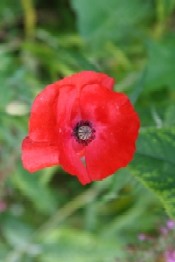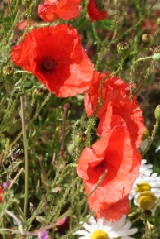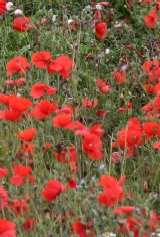



Field Poppy
Papaver rhoeas
Other
Names: Common Poppy, Corn Rose
Distribution: Native of cornfields which was once very
common throughout
Habitat: Wide variety of soil types including poor soils
and alkaline soils. It thrives in sunny situations.
Description: Native annual of cornfields which was once common
but is now becoming rare due to modern agricultural methods.
It is of medium height with bright scarlet red flowers from May to
October. Although each flower only lasts for one day, a vigorous
plant can produce over 400 flowers during the summer.
Wildlife: It is a good plant for attracting wildlife to
your garden.
Uses: Traditionally it
was used as a remedy for a number of ailments including aches and pains
and gout. A syrup produced from the petals was used to encourage
infants to sleep.
In more recent times, it has become the symbol of Remembrance Day. Due to the extent of ground disturbance, it was the flower which bloomed in between the trench lines and no man's land on the Western front in Flanders after battles of the First World War (1914-18).
Sowing
Instructions for Seeds:
Sow seed in situ in early spring. Alternatively, a sowing in
situ during autumn will produce larger and earlier-flowering plants.
The seed can also be sown in March in the greenhouse. Prick seedlings
out into pots & plant out in May.
Our plants and seeds are of native British origin.